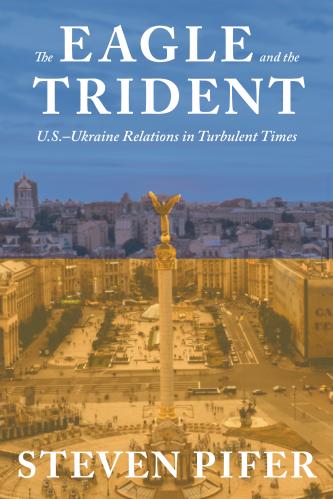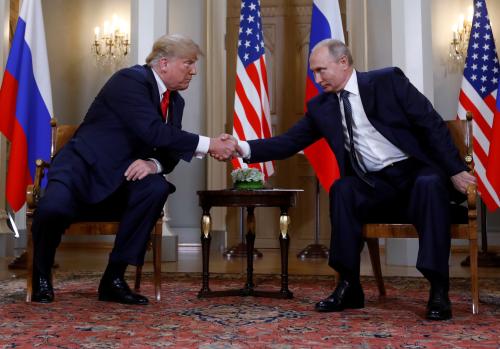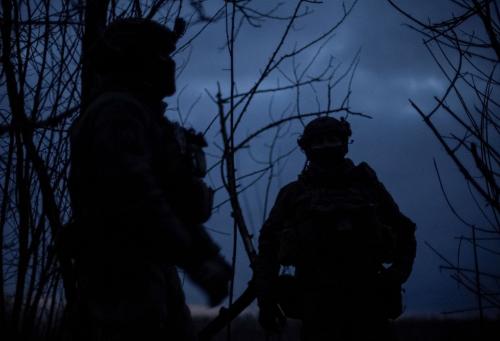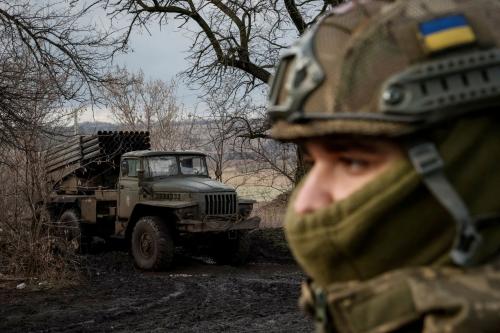On November 25, Russian border patrol ships attacked and seized three Ukrainian naval vessels attempting to transit from the Black Sea to the Sea of Azov via the Kerch Strait. That violated both maritime law and a 2003 Ukraine-Russia agreement that governs passage through the strait.
The attack foreshadows a Russian bid to establish unilateral control over the Kerch Strait and perhaps blockade Ukrainian ports on the Sea of Azov. Unfortunately, the United States and Europe have reacted weakly, largely limiting their responses to expressions of concern. The West should make clear that Russia will face concrete consequences if it does not release the Ukrainian naval vessels and crews and allow Ukraine free passage through the strait.
What happened?
On the morning of November 25, three Ukrainian naval vessels—a tug and two small gunboats—approached the southern entrance to the Kerch Strait. After transiting the Black Sea from Odesa, they sought to pass through the strait to a Ukrainian port on the Sea of Azov, following a course taken by two other Ukrainian gunboats in September. Although they were military vessels, the Ukrainian ships had a right of innocent passage. Moreover, a 2003 agreement between Ukraine and Russia states that Ukrainian- and Russian-flagged ships, both merchant ships and state non-commercial vessels, have a right to free navigation in the Strait of Kerch and Sea of Azov, which the sides consider the internal waters of Ukraine and Russia.
While Ukrainian and Russian accounts differ as to some details of what happened, their stories coincide on key points. Russian border patrol vessels intercepted the three Ukrainian ships in the southern approach to the strait, and the Russian vessel Don rammed the Ukrainian tug Yani Kapu. Video and audio from the Don make clear the Don’s intention to ram.
The Ukrainians say the Russian vessels sought to ram the Berdyansk and Nikipol gunboats as well, but the smaller, more agile Ukrainian ships successfully maneuvered out of the way (Russian aerial photos show the sides’ ships circling and maneuvering). In the process, it appears that the Russian vessel Izumrud rammed, or was rammed by, another Russian ship, possibly the Don.
The three Ukrainian ships then maintained station for much of the day in Russian-controlled waters at the south entrance to the Kerch Strait. In the meantime, the Russians physically blocked the main passage through the strait, positioning a tanker under the central span of the Kerch bridge.
That evening, apparently having concluded that they would not be allowed passage into the Sea of Azov, the Ukrainian vessels turned south toward the Black Sea, exiting the approach to the strait. Russian border patrol vessels intercepted the Ukrainian ships, ordered them to halt and then opened fire, wounding several Ukrainian crewmen. The Russians boarded and seized the Ukrainian vessels. Crucially, as Bellingcat has showed, Ukrainian and Russian data agree that the attack took place in the Black Sea more than 12 nautical miles off the coast of Russian-occupied Crimea—that is, in international waters. The Russian action is indefensible, particularly as the Ukrainian ships clearly were heading away from the Kerch Strait when attacked.
What’s at issue?
Since seizing Crimea in 2014, the Russians have moved to tighten control over the Sea of Azov. The bridge they built to link the city of Kerch in Crimea to the Taman peninsula on the Russian mainland prevents the passage of larger ships that used to call at the Ukrainian port of Mariupol on the Sea of Azov. Mariupol is Ukraine’s third busiest port, exporting steel, iron and grain. Over the past nine months, the Ukrainians have complained that Russian patrol boats have stopped, boarded and/or harassed commercial vessels bound for Ukrainian ports on the Sea of Azov as well as Ukrainian fishing boats.
Russia seems to be trying to establish unilateral control over passage through the Kerch Strait and the Sea of Azov.
Russia seems to be trying to establish unilateral control over passage through the Kerch Strait and the Sea of Azov. The Ukrainians fear that Russia will impose an economic blockade on Ukrainian ports in a bid to up the economic pressure on Kyiv. During the week of November 26, the Ukrainians reported that ships bound for Ukrainian ports on the Sea of Azov were not being permitted passage through the Kerch Strait.
The West is concerned
Late on November 25, the European Union and NATO called on Russia to ensure unhindered passage for Ukrainian ships into the Sea of Azov. Officials of various Western countries began speaking up the next day, indicating various degrees of concern. With thanks to @sovietsergey, we learned that:
- The Slovenian, Romanian, and Finnish foreign ministries and Swedish foreign minister were “deeply concerned.”
- The Austrian foreign minister was “seriously concerned.”
- The Dutch foreign minister was “severely concerned.”
- The Czech foreign ministry was “highly concerned.”
- The French foreign ministry was “profoundly concerned.”
- The G-7 foreign ministers expressed “utmost concern.”
Some went further. The Lithuanian foreign ministry, Canadian foreign minister, and EU president “condemned” the Russian action, while the British foreign secretary “utterly condemned” it.
Washington had nothing to say on the 25th. The next day, Ambassador to the U.N. Nikki Haley and Secretary of State Mike Pompeo made strong statements, but President Donald Trump almost immediately undercut them when he seemed to take a neutral position. National Security Advisor John Bolton did not help on November 27 when spelling out topics for the planned Trump meeting with Russian President Vladimir Putin on the margins of the G-20 summit; he had to be prompted to put Ukraine on the list.
In an interview that same day, Trump suggested he might cancel the meeting with Putin. On November 28, however, U.S. and Russian officials indicated that the meeting was on, which the president reaffirmed the morning of November 29 before heading to Andrews Air Force Base. Then, from Air Force One en route to Argentina, he tweeted that the meeting was off, citing Russia’s seizure of the Ukrainian ships and sailors (most thought the more likely reason was that morning’s news of the guilty plea by his former lawyer and reports about his company’s efforts to build a Trump Tower in Moscow).
Nothing suggests that these expressions of concern and condemnation, or Trump’s on again/off again handling of his meeting with Putin, caused anxiety in the Kremlin. Putin in Argentina brushed off the complaints of his Western counterparts. One week after the attack, the Yani Kapu, Berdyansk, and Nikipol remain impounded at a Russian facility in Kerch, the ships’ crews sit in Lefortovo Prison in Moscow, and Russia continues to harass ships traveling to Ukrainian ports in the Sea of Azov.
The West should get serious
Russia’s November 25 attack on the Ukrainian ships was a test of Kyiv’s reaction. It was also a test of how the West would respond. Unfortunately, the West is failing miserably. If the United States and Europe do not wish to see Russia solidify its control over the Sea of Azov and blockade Ukraine’s ports, they have to make clear to Moscow that there will be consequences.
The West could consider military steps such as increasing the tempo of visits by NATO warships to the Black Sea (that tempo has already increased since Russia’s seizure of Crimea). The presence of NATO warships, particularly U.S. Navy vessels capable of carrying sea-launched cruise missiles, clearly irks the Kremlin.
Some have suggested that NATO send warships into the Sea of Azov. That would not prove wise. First, it could well provoke a shooting conflict in a region where Russia has geographic advantages. Second, it would violate the 2003 agreement, which requires the approval of both Ukraine and Russia for third-country naval vessels to enter the Sea of Azov. The West should not take actions that would delegitimize that agreement, as it is critical to Ukraine’s claim for open access through the Kerch Strait.
The United States and other NATO countries, on a national basis, might weigh what additional military assistance would be appropriate for Ukraine in view of Russia’s latest military escalation.
The United States and European Union should consider additional economic sanctions on Russia. They could draw on the following list of examples:
Making Moscow understand that unacceptable actions will have growing costs is key to changing calculations in the Kremlin.
- Prohibit U.S. and EU member state-flagged ships from calling on Russian ports on the Sea of Azov and Black Sea.
- Prohibit ships with cargos from Russian ports in the Sea of Azov and Black Sea from entering American and European ports. (Annegret Kramp-Karrenbauer, a close political ally of German Chancellor Angela Merkel and candidate to succeed her as head of Germany’s Christian Democratic Union, has already suggested closing European ports to ships from Russian ports on the Sea of Azov.)
- Target Russian state-owned banks or parastatal companies for specific sanctions. (In April, when the U.S. government announced sanctions on United Company Rusal, a large Russian-based aluminum producer, the company’s stock plunged by 50 percent, while the Moscow stock exchange’s index lost 8 percent. The Treasury Department subsequently eased the sanctions, but the case demonstrates that the West can inflict significant economic impacts on Russian entities.)
- Suspend work on the Nord Stream II pipeline. The pipeline project is dubious as a commercial project. Refurbishing the existing pipeline network that transits gas through Ukraine would be less expensive, but Moscow wishes to end the transit fees it pays Kyiv and have the ability to totally shut off gas into that pipeline network.
The Kremlin tries to put on a brave face about sanctions, but they do cause economic pain, particularly for a stagnant Russian economy that is growing at less than 2 percent per year. Making Moscow understand that unacceptable actions will have growing costs is key to changing calculations in the Kremlin.
This situation cries out for leadership from Washington, and it would behoove the Trump administration to act. First, it could coordinate with European allies on sanctions that would have broad impact and signal trans-Atlantic unity in the face of Russia’s unacceptable actions. Second, administration action would forestall new congressional sanctions, which likely would be less finely targeted and more difficult to remove if/when Russia corrected its misbehavior.
If the West takes no action, it should get used to Moscow treating the Sea of Azov as a virtual Russian lake. And it should think what next steps an emboldened Moscow will attempt in its conflict with Ukraine and hybrid campaign against the West.






Commentary
The battle for Azov: Round 1 goes to Russia
December 3, 2018